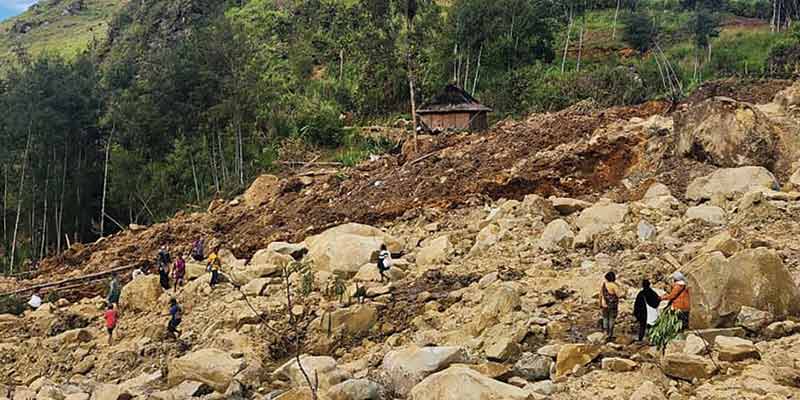- World
- May 27
What are landslides? How do they occur?
• The Papua New Guinea government said a landslide on May 24 buried more than 2,000 people and has formally asked for international help.
• The government figure is around three times more than a United Nations’ estimate of 670.
• Estimates of the casualties have varied widely since the disaster occurred.
• Australia has prepared to send aircraft and other equipment to help at the site of a deadly landslide in Papua New Guinea. Papua New Guinea is Australia’s nearest neighbour and the countries are developing closer defence ties as part of an Australian effort to counter China’s growing influence in the region.
Quick facts on Papua New Guinea:
• Papua New Guinea is an island country that lies in the south-western Pacific. It includes the eastern half of New Guinea and many small offshore islands.
• Its neighbours include Indonesia to the west, Australia to the south and Solomon Islands to the south-east. It is mainly mountainous but has low-lying plains in southern New Guinea. The country has several active volcanoes.
• In 1975, Papua New Guinea gained independence and became a member of the Commonwealth.
• The indigenous population of Papua New Guinea is one of the most heterogeneous in the world. Papua New Guinea has several thousand separate communities, most with only a few hundred people.
• Divided by language, customs, and tradition, some of these communities have engaged in tribal warfare with their neighbors for centuries.
• Capital: Port Moresby
• Population: 4.6 million
• Languages: English, Tok Pisin, Motu (official), and about 715 other languages.
What is a landslide?
• A landslide is defined as the movement of a mass of rock, debris, or earth down a slope.
• Landslides are a type of “mass wasting”, which denotes any down-slope movement of soil and rock under the direct influence of gravity.
• The term “landslide” encompasses five modes of slope movement: falls, topples, slides, spreads, and flows.
• These are further subdivided by the type of geologic material (bedrock, debris, or earth).
• Debris flows (commonly referred to as mudflows or mudslides) and rock falls are examples of common landslide types.
Causes of landslide
• When the force of gravity acting on a slope exceeds the resisting forces of a slope, the slope will fail and a landslide occurs.
External factors can lead to landslides happening, including:
i) Heavy rainfall leading to saturation of the ground.
ii) Erosion of the base of a slope.
iii) Changes to the material’s strength through weathering.
• A landslide may occur because the strength of the material is weakened. This reduces the power of the ‘glue’ that cements the rock or soil grains together. Located on a slope, the rock is then no longer strong enough to resist the forces of gravity acting upon it.
• Slope movement occurs when forces acting down-slope (mainly due to gravity) exceed the strength of the earth materials that compose the slope.
• Landslides can be initiated in slopes already on the verge of movement by rainfall, snow melt, changes in water level, stream erosion, changes in groundwater, earthquakes, volcanic activity, disturbance by human activities, or any combination of these factors.
• Earthquake shaking and other factors can also induce landslides underwater. These landslides are called submarine landslides. Submarine landslides sometimes cause tsunamis that damage coastal areas.
• In some cases human activities can be a contributing factor in causing landslides. Many human-caused landslides can be avoided or mitigated. They are commonly a result of building roads and structures without adequate grading of slopes, poorly planned alteration of drainage patterns, and disturbing old landslides.
• The impact of a landslide can be extensive, including loss of life, destruction of infrastructure, damage to land and loss of natural resources.
• Landslide material can also block rivers and increase the risk of floods. They also have a devastating effect on farmers’ livelihoods as they can prevent access to land for years, destroy seed and food stocks and will commonly result in the loss of livestock and standing crops.
Areas most vulnerable to landslides include:
i) Steep terrain, including areas at the bottom of canyons.
ii) Land previously burned by wildfires.
iii) Land that has been modified due to human activity, such as deforestation or construction.
iv) Channels along a stream or river;
v) Any area where surface runoff is directed or land is heavily saturated.
• Climate change and rising temperatures are expected to trigger more landslides, especially in mountainous areas with snow and ice. As permafrost melts, rocky slopes can become more unstable resulting in a landslide.
Manorama Yearbook app is now available on Google Play Store and iOS App Store

